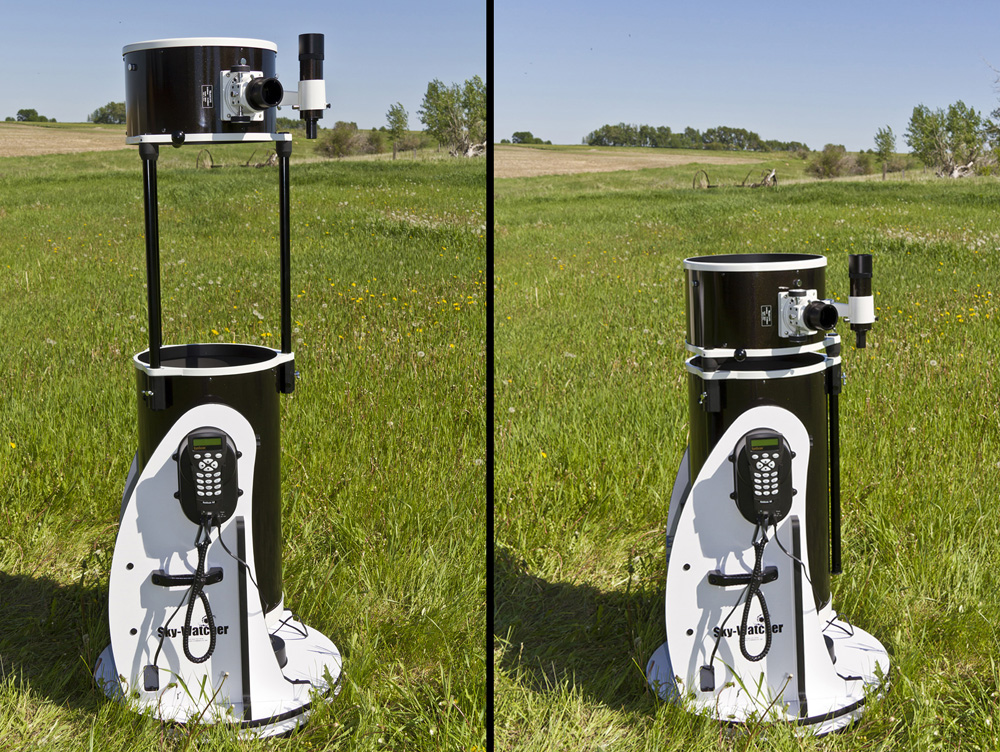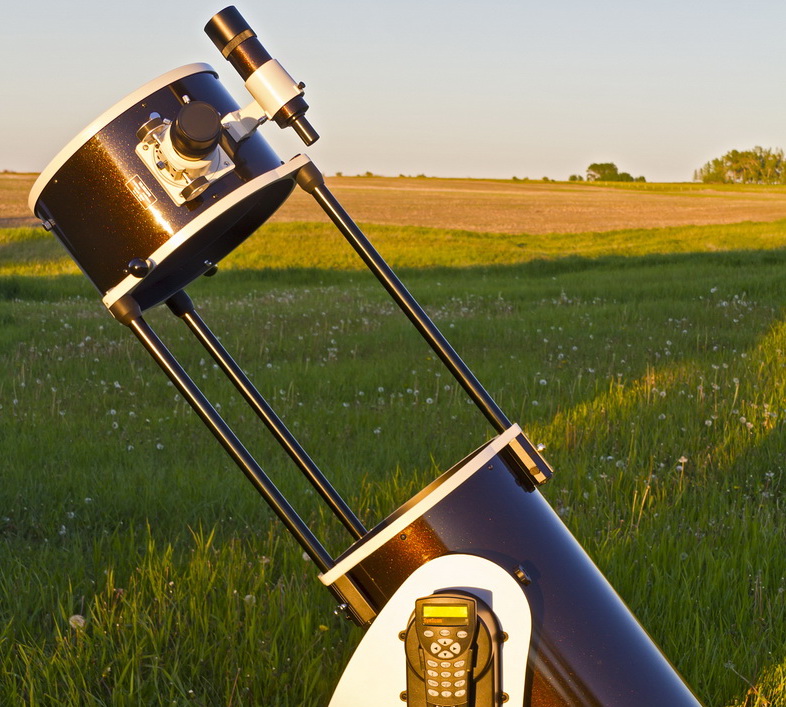I had to admit to being skeptical. Could the new Sky-Watcher SynScan telescopes really work? Up to now, mating a high-tech GoTo computer system to a Dobsonian-style reflector required kits costing thousands of dollars. Such a combination makes for a dream telescope, to be sure, delivering lots of aperture, practical portability and the convenience of automatic tracking and push-button object finding. But there’s the cost! One supplier of premium Dobsonians sells a 12.5-inch model with add-on computerized GoTo for upwards of $6,000.

Then along comes Synta. Under its Sky-Watcher brand name, the China-based company promises to deliver a 12.5-inch GoTo Dobsonian for one–quarter the price. Thus my skepticism. Motorizing what is, at heart, a nonprecision telescope design and having it slew to and track objects accurately is no small task. However, my doubts were allayed the first night out. Our test telescope, on loan from Pacific Telescope Corp., worked great. Surprisingly so.
How It Works

The new SynScan Series takes Synta’s excellent “Collapsible” design of reflector and mates it to an encoder and motor on each axis, operated by the well-proven SynScan hand controller and software. So rather than having to push the telescope around the sky, you simply press a button to call up any of thousands of objects. Hit Enter, and the telescope slews itself to your target, centres it and begins tracking. With this Dob, you don’t have to keep nudging it every minute or so to keep objects centred. High-power observing becomes practical.
I found that the telescope routinely placed all objects well within the one-degree field of a low-power eyepiece, sometimes nearly centred but usually no more than one-third of one degree away from centre. On several nights, I left the telescope tracking on objects and found them still well centred after two to three hours. This was true even of objects that passed nearly overhead at the zenith, a tough spot for a Dobsonian to reach.
Unlike many GoTo scopes, the SynScan models include encoders that keep track of the telescope’s position even if the scope is moved manually. Yes, you can physically push the telescope to a new target, then still use the GoTo to find and track more objects, very handy for public viewing, when scopes invariably get bumped. Few GoTo scopes can do this.

Setup is very easy. Unless you use the optional GPS module, you do need to enter your location once (it remembers it even after powering down), then enter the date and time each night. After that, you aim the telescope at one star by manually and electrically slewing it to a star either you or the system chooses (of necessity, you do have to be able to identify bright stars). Choosing the second star prompts the scope to slew to where it “thinks” that star should be. Centre the star with the slew buttons, hit Enter, and you are aligned. Other than ensuring that the telescope is reasonably level on solid ground, there are no special setup requirements. Each alignment attempt worked fine — I never saw the dreaded “Alignment Failed” message.
Another feature that worked fine was the Park Telescope command. With this, it’s possible to place the telescope in either a default Home position (level and aimed north) or any position you like and then turn off the scope. As long as it is not physically moved in the interim, you can wake it up the next night and resume finding and tracking objects without having to repeat the two-star alignment—just enter the new date and time.
SynScan Software
The well-honed SynScan software proved bug- and crash-free. It offers a good selection of targets, including all the deep-sky objects in the Messier, Caldwell, NGC and IC catalogues. The solar system database contains the Moon and all the planets (yes, Pluto too), but alas, no comets or asteroids. There is a nice selection of double and variable stars and a place to store 25 user-defined objects.
The hand controller comes with an RS-232 cable for connecting to an external computer. Using a Carina SkyFi box, I was able control the telescope with an iPad. Carina’s SkyVoyager software for iPhone and iPad shows oodles of objects, just the ticket for a big scope like this. Having an interactive star chart in your hands to match the eyepiece field is wonderful for exploring fields of galaxies.
Computers and motors take power. While the SynScan Dobs come with a D-cell battery pack, I found it powered the scope for barely a night’s use. Instead, I used a “jump-start” battery from Canadian Tire most nights. While it lasted longer, it was too big to ride along with the telescope. Thus I discovered a function missing from the software: Anti-Cord Wrap. The telescope always takes the shortest route from object to object, so I did find it wrapping the power cord around its base, to the point where it pulled the plug on me one night.
The Basics

A fancy computer isn’t much good if the basics aren’t there. However, I found the Chinese-made f/5 optics to be excellent, with no obvious aberrations or optical flaws. Images snapped into precise focus. Saturn showed crisp detail, and when the seeing allowed, close double stars were cleanly resolved. Sliding the tube up and down did not seem to compromise the collimation. When placed on a solid surface, the telescope was stable and dampened down in just one second from normal bumping and handling. The only proviso is that while the telescope can be used as a normal push-around Dobsonian, the additional friction of the axes (particularly in azimuth) required for the motor mechanism makes the scope a little stiff and hard to move in small increments. It does not have the buttery smoothness of a classic Dob. I would consider manual movement as a fall-back mode to be used only if batteries fail. Still, it is nice to have.
Buying Advice
We tested the 12.5-inch model, thinking this to be the most popular choice for avid deep-sky observers. At $1,700, it is a bargain for a GoTo telescope of this aperture — a 12-inch Schmidt-Cassegrain goes for $3,600 or more.
But be warned: As with any large telescope, this is a hefty item. Yes, it breaks down into the rocker box and tube, but these weigh 23 and 20 kilograms (50 lb/44 lb), respectively. On top of that, they are large and unwieldy. This is not a telescope for spur-of-the-moment backyard sessions. Nor for anyone with back problems! It is best used in an observatory or at a dark-sky site, where it can be left set up or easily wheeled out from a shed or garage. If you have to carry your gear up and down stairs and through many doors, the 12.5-inch SynScan is not the scope for you. Cool your aperture fever, and settle for an 8-inch ($1,200) or a 10-inch ($1,400) model instead.
With its SynScan Dobsonians, Sky-Watcher has produced large GoTo telescopes at breakthrough prices. Some might argue that Dobsonians appeal only to hard-core visual observers who shun anything high-tech, while the high-tech savvy buyers always opt for photo-capable Schmidt-Cassegrain telescopes (SCT). To the skeptics, a GoTo Dob might seem like a mismatched hybrid.
But I’d argue that once you use a large-aperture Dobsonian with GoTo and tracking, it’s hard to go back to “hunt, push, and nudge, nudge, nudge.” Conversely, many tech-oriented buyers might never use all the features and photo potential of an SCT. Plus the fast f/5 focal ratio of a large Dob is wonderful for “wide-field” views of many deep-sky objects and star fields — a jumbo 31mm Nagler eyepiece worked beautifully with this scope. So for me, the Sky-Watcher SynScan’s combination of Dobsonian design and GoTo convenience is, indeed, a match made in heaven.
SPECIFICATIONS: Sky-Watcher 12.5-inch Reflector
Aperture: 12.5 inches (30 cm)
Focal length: 1,500 mm
Focal ratio: f/5
Weight: Mount 23 kg; Tube 20 kg
Standard accessories: 8×50 finderscope, Crayford focuser with 2-inch, 1.25-inch and photo adapters, RS-232 cable, battery pack, DC power cord, 10mm and 25mm Plössl eyepieces.





